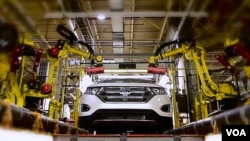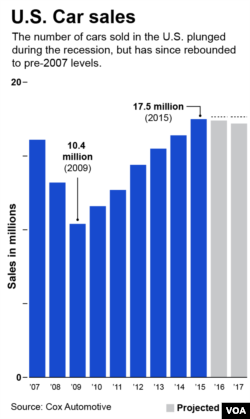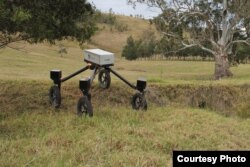While the takeover of trucking by computerized robots is considered inevitable, how soon it will happen is a matter of debate. Some say it will take years to fully develop. Others predict it will happen much sooner. Massive, autonomous mining trucks move giant loads of earth and ore in Australia and elsewhere. The trucks are able to handle the very limited traffic seen in the mine, but the chaos of the open road will be a bigger challenge. The head of engineering for the American Trucking Association, Ted Scott, says it will take time to work out regulations, testing and public acceptance. “With the technology that is there, we can take the driver out of the vehicle. We aren’t gonna do that for a long time."
More automation, fewer people on the production line.
Volvo and Uber have announced a plan to test self-driving cars in Pittsburgh, and Ford recently announced a joint research effort with a Chinese company to push self-driving vehicle technology forward. Audi and others are testing robot drivers in ever more complex environments, including Audi's race up a large American mountain and big city traffic. A former official of the National Highway Traffic Safety Administration, Chan Leiu, says these tests may speed things up: "We are not that far from the ultimate vision of a completely self-driving car." Leiu says autonomous vehicles literally put people’s lives in the hands of robots. But that may be a good thing because he says 94 percent of accidents are caused by people who are tired, drunk, texting, or making other mistakes. This could save tens of thousands of lives, according to Notre Dame professor Tim Carone. "There's a journey to get there, but the journey ends with (an) order of magnitude decrease in (the) number of accidents, number (of) fatalities, number of injuries."
Human workers
Truck drivers, such as 16-year road veteran Rogelio Rada, think it will be quite a while before robots take their jobs. “Robots can only do so much...there’s issues I believe that only a person can handle.“ His colleague, Barry Waters, thinks it will be "probably 20-30 years down the road." Trucking employs as much as one percent of the U.S. population. The potential for changes in the industry follow decades of mostly declining human employment in U.S. manufacturing. The trend is evident in the auto industry, which sold a record number of vehicles in 2015, but did so with far fewer workers than it once employed. Early in the age of autos, it took throngs of workers to build cars like the Model-T. Historic film shows waves of workers spilling out of factories at the end of their shift, where they did much of the work by hand with muscle power.
Competitive pressures forced manufacturers of all kinds to seek ever more efficient, less labor-intensive and cheaper ways to make products. Current video shows far fewer people on the factory floor as powerful robots weld, paint and preform other tasks, often with greater precision than their human predecessors. That is bad news for millions of workers like Holly Stover who was laid off after years of work for steel firms. “I hope I'll end up working a good, a decent job, making a decent living.” With help from an employment counselor, Stover is exploring new kinds of work and considering school to update skills. Georgetown University workforce expert Anthony Carnavale says more industrial robots means fewer humans have high-paying jobs on production lines. "Probably 75 percent of the job loss is technology-based. Robots, machines in general, are substituting for people.”
New opportunities


 )
)


